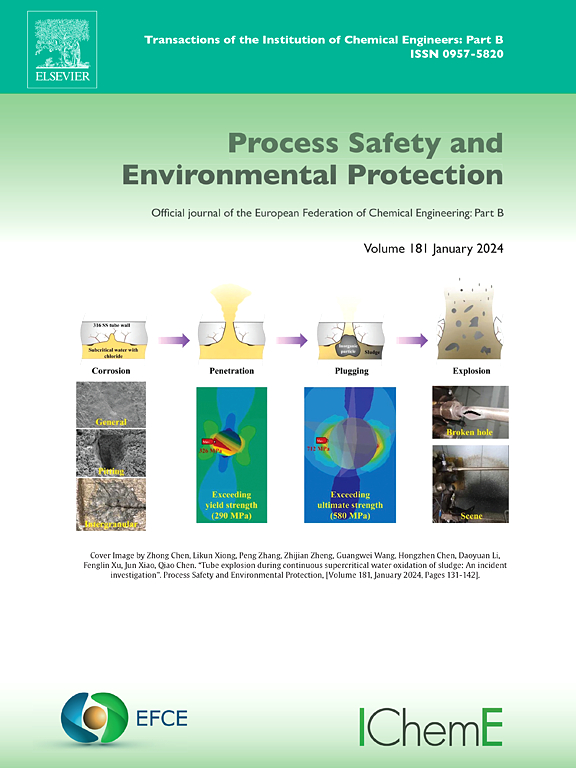In situ ultrasonic-backwash regeneration of upflow activated carbon filters for improved removal of organics from drinking water
IF 6.9
2区 环境科学与生态学
Q1 ENGINEERING, CHEMICAL
引用次数: 0
Abstract
In this study, in situ ultrasonic-backwash regeneration of upflow activated carbon filters for enhanced removal of organic matter from drinking water was investigated by treating granular activated carbon at different ultrasonication frequencies (40 and 120 kHz). The activated carbon was physically characterized before and after treatment by SEM, BET, FTIR, XPS, and XRD, and the microbial diversity of the biofilm on the regenerated activated carbon was also analyzed. The results of 120-day tracking analysis showed that ultrasonic-backwashing regeneration improves the organic-matter-removal efficiency by 5 %–13 %, with the regeneration effect of ultrasonic waves at 120 kHz being superior to that at 40 kHz. Characterization of the activated carbon showed that ultrasonic treatment increases its mesopore content while decreasing its particle size but does not change its elemental composition or crystal structure, although prolonged high-frequency sonication appears to decrease the number of oxygen-containing functional groups on the carbon surface, which may benefit wettability. Furthermore, the treatment does not change the core species of the microbial community on the activated carbon. Overall, the treatment is a cost-effective and efficient way to improve the removal of organic matter from drinking water.
上流式活性炭过滤器的原位超声反冲洗再生,以改善饮用水中有机物的去除
在本研究中,通过在不同的超声波频率(40和120 kHz)下处理颗粒活性炭,研究了上流式活性炭过滤器的原位超声反冲洗再生对饮用水中有机物的去除效果。采用SEM、BET、FTIR、XPS、XRD等手段对活性炭处理前后进行了物理表征,并对再生活性炭上生物膜的微生物多样性进行了分析。120 d的跟踪分析结果表明,超声波-反洗再生的有机物去除率提高了5 % ~ 13 %,其中120 kHz的超声波再生效果优于40 kHz的超声波再生效果。表征表明,超声处理增加了活性炭的中孔含量,减小了活性炭的粒径,但没有改变其元素组成或晶体结构,尽管长时间的高频超声处理似乎减少了活性炭表面含氧官能团的数量,这可能有利于润湿性。此外,处理不会改变活性炭上微生物群落的核心物种。总的来说,这种处理方法是一种经济有效的方法,可以提高饮用水中有机物的去除率。
本文章由计算机程序翻译,如有差异,请以英文原文为准。
求助全文
约1分钟内获得全文
求助全文
来源期刊

Process Safety and Environmental Protection
环境科学-工程:化工
CiteScore
11.40
自引率
15.40%
发文量
929
审稿时长
8.0 months
期刊介绍:
The Process Safety and Environmental Protection (PSEP) journal is a leading international publication that focuses on the publication of high-quality, original research papers in the field of engineering, specifically those related to the safety of industrial processes and environmental protection. The journal encourages submissions that present new developments in safety and environmental aspects, particularly those that show how research findings can be applied in process engineering design and practice.
PSEP is particularly interested in research that brings fresh perspectives to established engineering principles, identifies unsolved problems, or suggests directions for future research. The journal also values contributions that push the boundaries of traditional engineering and welcomes multidisciplinary papers.
PSEP's articles are abstracted and indexed by a range of databases and services, which helps to ensure that the journal's research is accessible and recognized in the academic and professional communities. These databases include ANTE, Chemical Abstracts, Chemical Hazards in Industry, Current Contents, Elsevier Engineering Information database, Pascal Francis, Web of Science, Scopus, Engineering Information Database EnCompass LIT (Elsevier), and INSPEC. This wide coverage facilitates the dissemination of the journal's content to a global audience interested in process safety and environmental engineering.
 求助内容:
求助内容: 应助结果提醒方式:
应助结果提醒方式:


